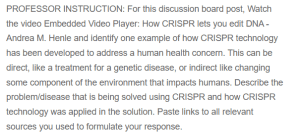CRISPR Technology in the Treatment of Sickle Cell Disease
CRISPR-Cas9 is a molecular tool used to edit genes; therefore, it can be applied to address health issues like sickle cell disease, an example noted in Andrea M. Henle’s video, How CRISPR Lets You Edit DNA (TED-Ed, 2019). Sickle cell disease (SCD) is a genetically inherited disease that occurs due to a malformation in the hemoglobin protein structure. Human hemoglobin has four globular subunits, with the β-globin protein (HbB) being the most common in adults. In SCD, the HbB gene undergoes a single mutation in chromosome 11, where valine substitutes glutamic acid in the sixth codon (Demirci et al., 2019). The mutated HbB gene produces hemoglobin S (HbS), a malformed form of hemoglobin that has binding sites for other HbS proteins. This allows for the polymerization of the hemoglobin molecules, which conglomerate when deoxygenated, thereby creating sickle-shaped RBCs. Notably, this sickle shape makes it challenging for red blood cells to transport oxygen. Ultimately, this malformation results in adverse clinical implications such as chronic anemia, organ failure, and early death (Demirci et al., 2019).
During fetal development and in infancy, the predominant globin is the fetal hemoglobin (HbF), which later switches to HbB. Remarkably, since SCD results from a mutation to the HbB gene, newborns do not show complications of SCD, as HbF makes up the majority of their hemoglobin. Accordingly, one approach of CRISPR technology in treating sickle cell disease is HbF induction, where gene editing is targeted to create a hereditary persistence of fetal hemoglobin (HPFH) genotype to increase the expression of HbF (Rheney, 2023). As such, Rheney (2023) notes that researchers at the University of California applied CRISPR-Cas9 to delete 13kb of the β-globin locus in SCD patients. Subsequently, this deletion yields an HPFH-like phenotype in SCD patients, resulting in increased HbF levels in red blood cells and ameliorated sickling.
Note: Links to all references used are indicated in the References Section below.
References
Demirci, S., Leonard, A., Haro-Mora, J. J., Uchida, N., & Tisdale, J. F. (2019). CRISPR/CAS9 for sickle cell disease: Applications, future possibilities, and challenges. In Advances in experimental medicine and biology (pp. 37–52). https://doi.org/10.1007/5584_2018_331
Cheney, J. (2023). Using Crisper in the treatment of sickle cell disease. Journal of Student Research, 12(1). https://doi.org/10.47611/jsrhs.v12i1.3889
TED-Ed. (2019, January 24). How CRISPR lets you edit DNA – Andrea M. Henle [Video]. YouTube. https://www.youtube.com/watch?v=6tw_JVz_IEc
ORDER A PLAGIARISM-FREE PAPER HERE
We’ll write everything from scratch
Question
DISCUSSION BOARD #4:
PROFESSOR INSTRUCTION: For this discussion board post, Watch the video Embedded Video Player: How CRISPR lets you edit DNA – Andrea M. Henle and identify one example of how CRISPR technology has been developed to address a human health concern.

CRISPR Technology in the Treatment of Sickle Cell Disease
This can be direct, like a treatment for a genetic disease, or indirect like changing some component of the environment that impacts humans. Describe the problem/disease that is being solved using CRISPR and how CRISPR technology was applied in the solution. Paste links to all relevant sources you used to formulate your response.

